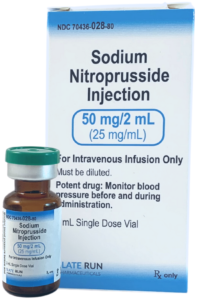SODIUM NITROPRUSSIDE
INJECTION
PRODUCT DETAILS
- Concentration: 50 mg per 2mL vial (25 mg/mL)
- Fill Volume: Sterile Solution in a 2mL vial
- Therapeutic Class: Vasodilator
- Closure does not contain any natural rubber or latex
- Preservative free
Saleable Unit:
2 mL vial Sterile Solution
Box of 1 vial
NDC Numbers:
50 mg per 2mL (25 mg/mL):
70436-028-80
Available through your wholesaler:
NDC: 70436-028-80
Cardinal Health: 5679634
McKesson: 1575182
Amerisource: 10250711
| Strength | NDC | Saleable Unit |
|---|---|---|
| 50 mg | 70436-028-80 | 50 mg in a 2 mL vial |
Store at 20° to 25°C (68° to 77°F). [See USP Controlled Room Temperature.]
To protect Sodium Nitroprusside Injection from light, it should be stored in its carton until it is used.
IMPORTANT SAFETY INFORMATION FOR: SODIUM NITROPRUSSIDE INJECTION
Sodium Nitroprusside Injection is not suitable for direct injection. The solution must be further diluted in sterile 5% dextrose injection before infusion.
Sodium nitroprusside can cause precipitous decreases in blood pressure. In patients not properly monitored, these decreases can lead to irreversible ischemic injuries or death. Sodium nitroprusside should be used only when available equipment and personnel allow blood pressure to be continuously monitored.
Except when used briefly or at low (< 2 mcg/kg/min) infusion rates, sodium nitroprusside gives rise to important quantities of cyanide ion, which can reach toxic, potentially lethal levels. The usual dose rate is 0.5 to 10 mcg/kg/min, but infusion at the maximum dose rate should never last more than 10 minutes. If blood pressure has not been adequately controlled after 10 minutes of infusion at the maximum rate, administration of sodium nitroprusside should be terminated immediately.
Although acid-base balance and venous oxygen concentration should be monitored and may indicate cyanide toxicity, these laboratory tests provide imperfect guidance.
Sodium Nitroprusside Injection should not be used:
- In the treatment of compensatory hypertension, where the primary hemodynamic lesion is aortic coarctation or arteriovenous shunting.
- To produce hypotension during surgery in patients with known inadequate cerebral circulation, or in moribund patients (A.S.A. Class 5E) coming to emergency surgery.
- In patients with congenital (Leber’s) optic atrophy or with tobacco amblyopia as these patients have unusually high cyanide/thiocyanate ratios.
- In the treatment of acute congestive heart failure associated with reduced peripheral vascular resistance such as high-output heart failure that may be seen in endotoxic sepsis.
Like other vasodilators, sodium nitroprusside can cause increases in intracranial pressure. In patients whose intracranial pressure is already elevated, sodium nitroprusside should be used only with extreme caution.
When sodium nitroprusside (or any other vasodilator) is used for controlled hypotension during anesthesia, the patient’s capacity to compensate for anemia and hypovolemia may be diminished. If possible, pre-existing anemia and hypovolemia should be corrected prior to administration of sodium nitroprusside.
Other adverse reactions reported include: methemoglobinemia, thiocyanate toxicity, bradycardia, electrocardiographic changes, tachycardia, rash, hypothyroidism, ileus, decreased platelet aggregation, increased intracranial pressure, flushing, venous streaking, and irritation at the infusion site.
Please see the package insert for Sodium Nitroprusside Injection for full prescribing information.

